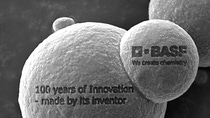Global
100 years of Iron Pentacarbonyl & Carbonyl Iron Powder (CIP) – made by its inventor!
BASF is the inventor and one leading producer of Iron Pentacarbonyl (IPC) & Carbonyl Iron Powder (CIP) worldwide.
In 1924, BASF filed the first patent for to produce IPC and started the mass production of IPC.
In 1925, BASF invented and started the carbonyl decomposition process for the production of CIP.
In the last 100 years, BASF has been continuously inventing novel CIP grades via smartly combing the pioneering process knowhow, versatile coating technologies and deep chemistry knowhow.
Dr.
Fangfang Chu
2024, BASF IPC & CIP celebrates 100 years of innovation!
Portfolio
- General Portfolio
- Inductor
- Radar Absorption
- Metal Injection Molding
- Diamond Tools
- Nutrition & food relevant applications









